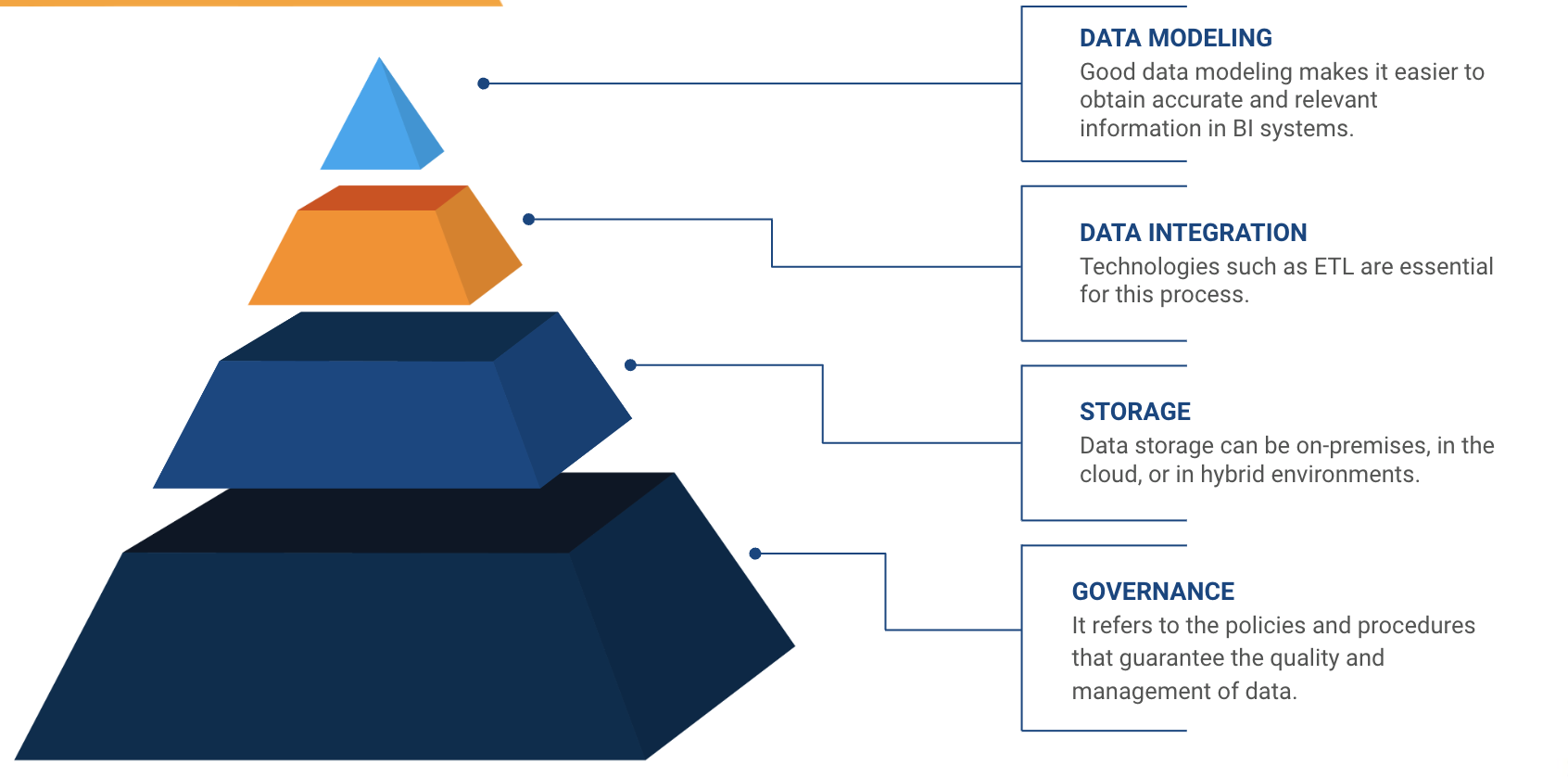
Business intelligence (BI) has become a fundamental pillar for business decision making. However, its success depends on a solid foundation: data architecture. In this article, we will see how data architecture plays a crucial role in business intelligence and how its correct implementation can transform data analysis into strategic value.

What is data architecture?
Data architecture is the organizational framework that defines how data is collected, stored, managed, and used within an organization. It is a structure designed to ensure that data is accessible, consistent, and usable across different platforms and for various purposes. This framework includes components such as databases, data flows, integration processes, and security policies.
Good data architecture ensures that data flows correctly from its source to business intelligence systems, ensuring its integrity, availability, and security.
The Key Role of Data Architecture in Business Intelligence
Business intelligence relies on the ability to analyze large amounts of data to derive actionable insights. Without a solid data architecture, analysis would be ineffective or even erroneous. Data architecture serves as the backbone of BI by providing the following benefits:
Fast and efficient access to data: Business decisions must be made with accurate, real-time data. A well-designed architecture ensures that data is organized and easily accessible to BI tools.
Data quality and consistency: Data architecture ensures that data flowing into BI platforms is consistent and correct. It prevents duplication and errors, resulting in reliable reporting.
Data security: In an environment where privacy is crucial, data architecture must include security policies that protect sensitive data, without compromising its accessibility for analysis.

Essential Components of a Data Architecture
For a data architecture to be effective and contribute significantly to business intelligence, it must have certain key components:
1. Data Modeling
Data modeling refers to how data is structured and organized. It defines how different data elements relate to each other, allowing for efficient navigation and querying. Good data modeling makes it easier to obtain accurate and relevant information in BI systems.
2. Data Integration
Data integration ensures that information from multiple sources is combined in a coherent and accessible manner for business intelligence platforms. Technologies such as ETL (Extraction, Transformation, and Loading) are fundamental to this process, as they transform raw data into usable information.
3. Data Storage
Data storage can be on-premises systems, in the cloud, or in hybrid environments. Regardless of its location, the architecture must be designed to support large volumes of data and allow for fast and secure access. Data warehouses are key tools in this regard, as they store historical data for analysis in BI.
4. Data governance
Data governance refers to the policies and procedures that ensure the quality, security and proper management of data. It includes aspects such as regulatory compliance, access management and the definition of standards that ensure that the data used in business intelligence is reliable and secure.

Business Intelligence: Turning Data into Insights
Business intelligence transforms raw data into actionable information through analysis, reporting, and visualizations. But without a solid data architecture that structures and organizes the information, these efforts would be ineffective.
1. Predictive Analytics
Predictive analytics is an essential part of modern business intelligence. It uses advanced techniques such as machine learning and data mining to foresee future trends based on historical data. Without a robust data architecture, predictive algorithms cannot access the information needed to make accurate forecasts.
2. Data Visualization
Data visualization is key to making business intelligence understandable and accessible to decision makers. Without a proper data architecture, BI tools cannot generate accurate visualizations, as the quality of visual representations directly depends on the quality of the underlying data.
Challenges in Implementing a Data Architecture for BI
Despite the clear benefits, implementing a robust data architecture can be challenging. Common obstacles include:
- Lack of alignment between IT and the business: If technology teams and business leaders are not aligned, the data architecture may not meet organizational expectations.
- Data silos: Fragmented data across different departments or platforms is a challenge for any business intelligence strategy. An effective data architecture must break down these silos and enable a unified view of information.
- Scalability: With exponential data growth, the architecture must be flexible enough to scale without compromising performance or security.

Best Practices for Designing a Successful Data Architecture
Designing an effective data architecture requires careful planning and a strategic approach. Here are some best practices:
1. Adopt a modular architecture
A modular data architecture allows for greater flexibility. With independent modules handling specific aspects, such as integration or storage, it is easier to upgrade or scale parts of the system without disrupting overall operation.
2. Process Automation
Automating tasks such as data ingestion, cleansing, and validation can improve system efficiency and reduce the risk of human error. This, in turn, ensures that the data processed by BI is always accurate and up-to-date.
3. Continuous Monitoring
It is essential to have a monitoring system in place that can identify potential problems before they affect business intelligence operations. Monitoring also helps ensure that the architecture can handle new volumes of data and adapt to changing business needs.
Data architecture is essential to maximizing the value of business intelligence. By properly structuring, integrating, and governing data, organizations can gain valuable insights that drive growth and efficiency.
For business leaders, understanding and prioritizing a robust data architecture is key to fully leveraging the benefits of BI and making informed decisions that drive organizational success.

